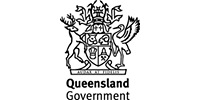Reef Rescue - Turkey Station
Fencing and watering points for improved grazing management at BororenYear: 2009
Program: Reef Rescue
The People

John and Kate Bell, ‘Turkey Station’, Bororen are committed to producing prime beef for the Jap Ox market, while caring for the land for future generations.
With some assistance from the ‘Caring for Our Country’ Reef Rescue program, John and Kate set about controlling erosion, installing additional internal fencing and additional watering points.
The property consists of coastal sandy soils appropriate for improved pastures. The property is positioned on the Baffle coast, as shown in the satellite image (right).

The Issues

The Top Bullock paddock is…
-
- too large of a paddock, with no ability to spell the pastures.
Middle Bullock paddock is…
- too large of a paddock, with no ability to spell the pasture. It also has too few watering points resulting in uneven pasture utilisation.
Bullock Pastures Paddock has…
- only one water point, with cattle overgrazing the pastures adjacent to the water point.

The Plan

Top bullock paddock…
- To erect fencing to split this bullock paddock into two smaller paddocks
Middle bullock paddock…
- To erect fencing to split this paddock into two smaller paddocks.
- As one of the new paddocks (the larger of the new middle bullock paddock), did not have any water for stock, the Bell’s provided an additional water point, in the form of a dam.
Bullock Pasture paddock…..
- To provide stock with an additional water point, in the form of a dam.
The Bell’s contributed more than $1.25 for every Reef Rescue funding dollar and contributed 100% toward the labour of the fence and financed the construction of one dam.

The Result

The creation of smaller paddocks and additional water points will allow more even grazing distribution throughout ‘Turkey Station’. This division of paddocks will allow for the rotation of grazing and will give the opportunity for pasture spelling.
The project undertaken by the Bell’s will benefit the reef by reducing the quantity of sediment reaching the Great Barrier Reef Lagoon. This benefit will come about as a result of both an increase in water points and the ability to rotate cattle and rest the pasture.
The increase in the number of water points will help reduce grazing pressure from the limited number of existing water points. The decreased grazing pressure surrounding the existing water points will lead to an improvement in ground cover.
“Last year, we divided a large paddock into two, allowing us to rest the pasture in these two paddocks. This year, Reef Rescue funding was available, which allowed me to install additional fencing and water points. This additional infrastructure has given me the ability to spell my pastures, along with making it easier to manage the herd” John Bell.

The Future

John and Kate are committed to sustainable land practices. They are progressive and innovative producers in the Bororen area.
John and Kate are involved in broadening their knowledge on property management planning, and utilise the latest technology, such as computer mapping, to help determine management goals.
Their eagerness to continue learning, along with their continual improvement of their property, will assist them to progressively produce beef for the Jap Ox market.
About Reef Rescue
Reef Rescue was a key component of Caring for our Country, the Australian Government‘s initiative to restore the health of Australia’s environment and improve land management practices.
The Burnett Mary Reef Partnership provided incentives to farmers and graziers in the Great Barrier Reef catchment to improve farm management practices, mainly to keep their fertiliser, soil and chemicals on farm.
The Burnett Catchment Care Association (BCCA) was involved in the delivery of the grazing component of Reef Rescue for the Burnett Mary Regional Group.
Program Sponsors
This project was supported by the following partners and investors.




